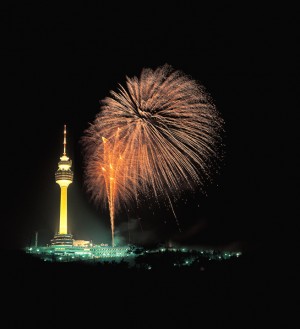The Linear Collider Physics/Detector Group of ACFA (Asian Committee for Future Accelerators) and the Global Design Effort (GDE) of the ILC are sponsoring a joint ACFA physics and detector workshop and GDE meeting on the International Linear Collider. The meeting, called KILC12, will be held in Daegu, Korea from Monday April 23 through Thursday April 26. The ACFA workshop will be devoted to studying the physics case for high-energy linear electron-positron colliders, especially in light of recent results from CERN’s LHC. There will also be a review on the progress on detectors.
Daegu, the meeting site, is located in southeastern Korea and has a population of 2.5 million. In addition to being a large modern metropolitan city, Daegu has a long and colourful history tracing back to about 1000 BC. Daegu was important in the process of opening up Korea to the rest of the world in the late 19th century, and in recent years, it has experienced explosive growth as a manufacturing city for textiles and various mechanical products.
As I indicated above, the ACFA-sponsored GDE plenary meeting has two main goals: to collect and assemble both the draft Technical Design Report (TDR) text and cost estimate information for the TDR and to make preparations for the transition to the post-TDR Linear Collider organisation. As a result, the meeting agenda is structured to give priority to TDR preparations, by providing adequate time for both authors and editors to meet, as well as for group leaders and cost engineers to meet.
The Daegu meeting will include a full set of parallel session reports summarising ongoing and planned R&D. However, unlike previous meetings, the upcoming ACFA meeting will have a special focus on recent technical decisions, as these define the baseline for the technical design. This will make sure the community at large understands all the decisions that have been taken for the TDR baseline, and gives the opportunity to raise for discussion any questions that remain. These reviews of the ILC R&D will also be helpful in defining goals and priorities for post-TDR studies.
This meeting comes at a crucial time when we will be completing the transition from determining technical details to writing the Technical Design Report for the accelerator and the Detailed Baseline Design report for physics and detectors. Our schedule is to submit these reports in advanced draft form to the International Linear Collider Steering Committee by the end of 2012. They will be reviewed technically and for cost early next year and we will then revise the TDR as needed and present it in final version to ILCSC and ICFA at the Lepton-Photon 2013 conference in San Francisco.
This submission will complete the mandate of the GDE!
Perhaps it is appropriate for us to meet in Daegu, a city noted for its large stone Buddha, called Gatwabi. People come from afar to visit this Buddha that is wearing a “gat,” a traditional Korean hat. But more intriguingly, it is said that visiting the Buddha helps make one wish come true. Maybe it is time for those of us who have worked so long and so hard towards the ILC to also make our one wish known to Gatwabi.




Recent Comments